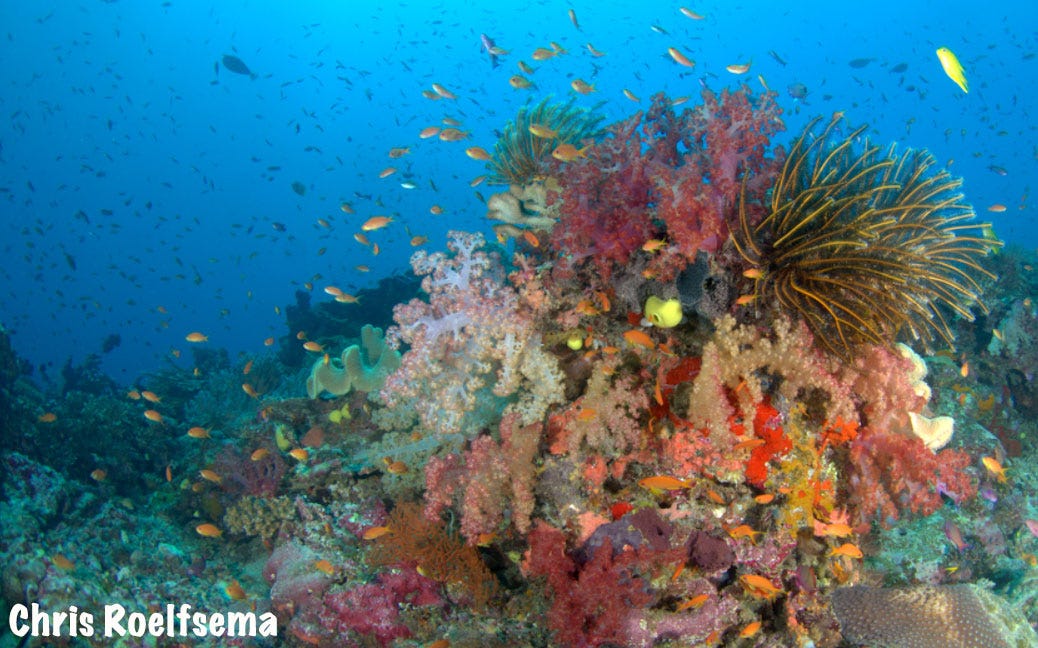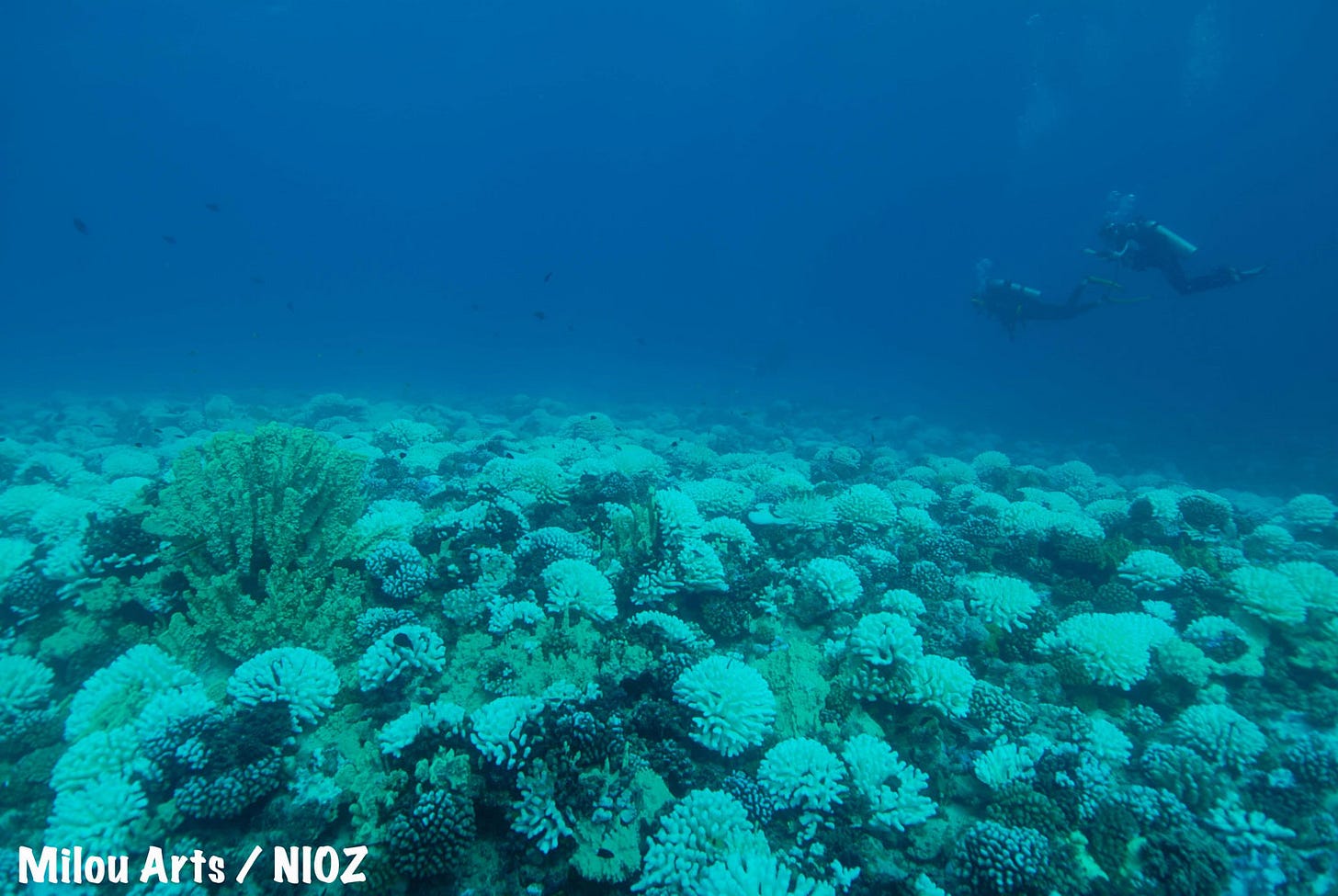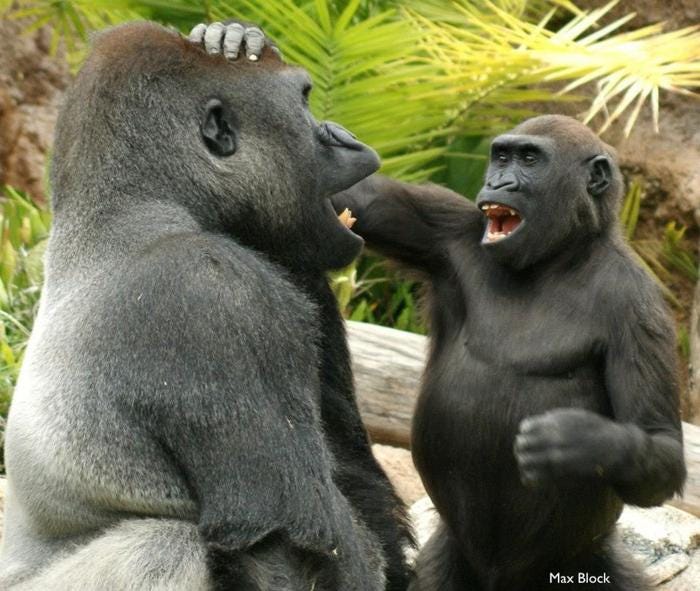Funny apes, coral reefs, vaccine mandates, universal emojis, and beefy rice (literally)
Issue #3 of American Journalist
Thursday, February 15, 2024
1. “Beefy–Rice”—Coming to a store near you?
A lot of attention was paid 11 years ago when the first puck-like Sergey Brin-backed burger patty was formed and fried from cultured bovine muscle cells grown in the lab. There was attention, excitement, accolades, and the promise that one day we would all be eating better tasting, more environmentally friendly, and less expensive lab-grown meat. (That first burger cost hundreds of thousands of dollars and took months of excruciating work to make.)
In the years since there has been a LOT more excitement, companies launched, billions of VC dollars piled on like pickles and ketchup, and yes! even a few lab-grown products that have wended their way out of the lab, garnering FDA approval for sale in the United States (and also in Singapore and Israel). I needn’t bother updating you here, since The New York Times did an outstanding article on this sector just a few days ago. Suffice it to say the reality still has not lived up to the promise, and some doubt it ever will.
Now researchers at Yonsei University and Chung-Ang University in Seoul, South Korea, have suggested a completely different approach to lab-grown meat—an agglomeration of sorts.
Rather than trying to grow animal cells and then form them into something resembling a patty or nugget, the Korean team has mixed grains of rice with fish gelatin and enzymes, which made the grain surfaces “sticky” for bovine cells. That allowed them to affix cow cells grown in the lab onto the surface of the rice grains, resulting in a protein-boosted hybrid one might call “beef–rice,” a future food if there ever were one.
“In the future, this self-production system of grain-based hybrid foods could ensure food relief in underdeveloped countries, during war, and in space,” the researchers write. Matter
2. Could data save the coral reefs?
Coral reefs are a rich worldwide scientific and cultural heritage. Ask anyone who has dived into or snorkeled atop these gorgeous rainforests-under-the-sea, and they will tell you. Coral communities are stunningly beautiful—and they’re economically essential besides. Collectively, the footprint of the world’s coral reefs is only 1 percent of the ocean floor, but they are home to an estimated one-quarter of all ocean marine life. A billion people around the globe depend in whole or part on these subsurface ecosystems for their daily food supply and annual income.
Now two unrelated studies, which came to our attention this week, have thrust Earth’s coral reefs into the spotlight once again.
The first study was the surprise finding from the University of Queensland in Brisbane, Australia, that there may be more coral reefs than previously thought. Using data from the Sentinel-2 and Planet Dove CubeSat satellites to produce a definitive estimate of the extent, distribution, and composition of the world’s shallow-water coral reefs, the researchers found they cover an area of 348,361 square kilometers (134,502 square miles), though they estimate only about a quarter of this area is actual coral habitat. The new maps are intended as tools for conservation and reef management, and they are publicly accessible on the Allen Coral Atlas and Google Earth Engine.
The second study is more depressing, as it focuses on the threat to coral reefs. Climate change drives warming oceans, which can stress and bleach coral reefs. And the damage may be worse than we thought. According to researchers at the University of Hawaiʻi at Mānoa and the Royal Netherlands Institute for Sea Research, climate-driven stress on reefs can actually amplify the damage to those reefs. They say that bleached corals alter locally dissolved organic matter, which could enhance microbial growth, causing further damage.
In a 2019 field study at Mo’orea, French Polynesia, during a prolonged period of high water temperatures, they witnessed a mass bleaching event and found that it “significantly increased growth of bacterioplankton, enriching copiotrophs and putative pathogens,” all of which could further stress fragile reefs. Communications Biology
BOTTOM LINE: For better or worse, the future of humanity is joined to these precious reefs. Their conservation is urgent, necessary, and it’s not simply a matter of fish or coral animal survival—this is about human survival!
3. Do vaccine mandates move the needle? Yes, but not in the way you might think!
Someone at the U.S. Centers for Disease Control and Prevention or in the Biden Administration set loose a trial balloon this week, presumably to test public opinion over a new CDC plan under consideration to reduce the isolation guidelines for people who have COVID-19. The new guidance would reportedly curtail the current five-day isolation period (down already from the original 10-day isolation dropped in 2021) and recommend instead isolating for just 24 hours after your fever subsides, which presumably means no isolation for people who have no fever. This would essentially mean people who are symptom-free but still testing positive for SARS-CoV-2—and possibly still shedding virus—would not need to isolate at all. (And don’t even ask about mask mandates!)
What about vaccine mandates? A paper this week from researchers at the University of Arizona suggests they have unintended consequences.
What we talk about when we talk about vaccine mandates are “selective” mandates—state employees, health workers, and the like. While 19 states put COVID-19 vaccine mandates in place for select workers during the pandemic, no state enacted a total mandate requiring all residents to be vaccinated. And 22 other states did something of the opposite, passing laws that restricted the ability of private companies to require people to be vaccinated as a condition of employment.
If you are interested, the National Academy for State Health Policy has a really nice tracker that shows which states enacted what laws and when.
The Arizona researchers found a paradox that shines a light on the very soul of America. First, they discovered that the selective mandates did not directly impact COVID-19 vaccination rates. There were no statistically significant changes in weekly jab rates before and after the mandates took effect in the 19 states imposing selective mandates. Second, the vaccine mandates did move the needle, but not in the way that was intended at all—basically in the opposite direction. In those 19 states, people were not only less likely to get COVID-19 boosters, voluntary child and adult influenza vaccination rates also fell the following year.
“Selective vaccination mandates can have harmful—or at least unintended—consequences for public health, which need consideration when creating such policies,” the researchers write. PNAS
4. Disgust is universal, but happiness is not?
If a picture says a thousand words, how long a phrase does an emoji evoke? Apparently, according to psychologists at the University of Nottingham in England, that would depend on your age, race, and culture.
Recruiting 523 people in the United Kingdom and China aged 18–81 (about half men and half women), the researchers offered them a chance to win a £20 Amazon gift card if they did a quick sorting task, classifying 24 emojis on four major platforms into six categories of emotion.
The results showed that women more accurately classified the happy, sad, and angry emojis and that age had a significant effect on accuracy. The older a person was, the less accurately they sorted the emotions correctly. Culture had a direct impact as well. (Interestingly neither age, gender, nor culture influenced a person’s ability to correctly classify the squinty-mouth disgust emoji, which apparently everyone can recognize.)
Disgust aside, this very simple study shows emojis are far from universal as communication tools—not even the seemingly simple six tested. There may be even greater chances for misunderstanding if you are using an alien-headed, winky-eyed surprise emoji. Maybe we should all just go back to using emoticons ;) PLOS ONE
5. More papers we liked this week
THE PSYCHOLOGICAL IMPACT OF BULLYING
Never accept when people say schoolyard taunts and threats are some sort of children-will-be-children rite of passage. Lots of people are resilient to the effects of bullying, no doubt, but for many others bullying could have awful, destructive, and lifelong impacts on their health. Now a new study by psychologists at UCLA and the University of Glasgow proves it.
Based on the outcomes of some 10,000 children enrolled in the U.K.’s Millennium Cohort Study, the researchers found children bullied by other children at age 11 were more likely to suffer strong trust issues by age 14 and were 3.5 times more likely to develop significant mental health problems—such as anxiety, depression, hyperactivity and anger issues—by age 17. Maybe former first lady Melania Trump was right with her “Be Best” campaign. We need to stop bullying. Nature Mental Health
ONLINE IMAGES AMPLIFY GENDER BIAS
Looking at more than a million images and billions and billions of words of text from Google, Wikipedia, and IMDB associated with 3,495 categories like “nurse” and “banker,” researchers at the University of California, Berkeley discovered that routine reinforcement of gender bias is much more common in online images than in text. This was the image they themselves offered in their press package:
The implications of the study are that when people google different occupations, results returned as images rather than text are more likely to amplify gender bias. “Addressing the societal effect of this large-scale shift towards visual communication will be essential for developing a fair and inclusive future for the internet,” the researchers conclude. Nature
BETTER TO HIDE THAN RESIST
Evasion is apparently a survival adaptation for Escherichia coli bacteria, according to researchers at the University of Texas, Southwestern. Rather than solely evolving resistant genes that code direct countermeasures to antibiotics, some E.coli develop gene variants that help them invade the lining of the intestines, where they can hide in tissue compartments where the antibiotic concentrations are lower. Cell Host & Microbe
AIR POLLUTION AND SUICIDE RISK
Some 16 percent of all the suicides in the world each year occur in China, and a new study reveals a causal link between suicide risk and air pollution. Researchers in the United States and China found that a 1 standard-deviation increase in PM 2.5, the small airborne microscopic particles that lodge in your lungs, is linked to a weekly suicide rate increase of about 25 percent, with women over age 65 being particularly vulnerable. Nature Sustainability
A POINT-COUNTERPOINT ON AI IN HEALTH CARE
PRO: “If applied broadly to the challenges of primary care, generative AI has the potential to not only incrementally improve primary care but transform it. We believe AI can reduce many of the everyday challenges experienced by primary care clinicians as they strive to deliver high-quality care,” write doctors at the University of California, San Francisco and Harvard. JAMA Internal Medicine
CON: “The promise of AI is alluring but it must be integrated into the clinical landscape with great intention to avoid harming the clinician-patient relationship, further overwhelming these clinicians, and causing undue harm to patients,” counter two other doctors at UCSF. JAMA Internal Medicine
FUNNY APES
Primatologists at UCLA and the Max Planck Institute of Animal Behavior, Development, and Evolution of Cognition in Konstanz, Germany, have found evidence of human, childlike, intentionally funny “playful teasing” in four species of great apes: orangutans, chimpanzees, bonobos, and gorillas.
The fact that the desire toward playful teasing exists in all four species as well as humans suggests it may have evolved first in our last common ancestor, some 13 million years ago. What sort of jokes were the earliest? It’s impossible to say for sure, but given the prevalence of potty humor among children today, I am going to guess they were fart jokes. Perhaps the mysterious ancient missing link is really just “The missing stink.” Proceedings of the Royal Society B













